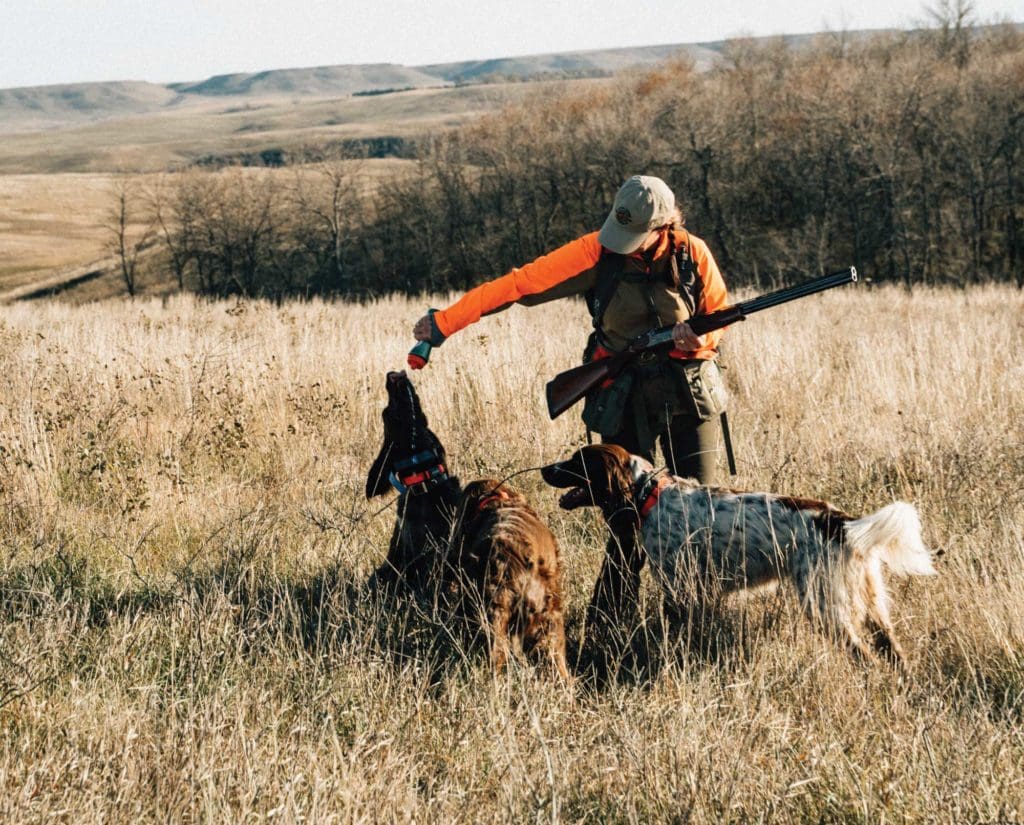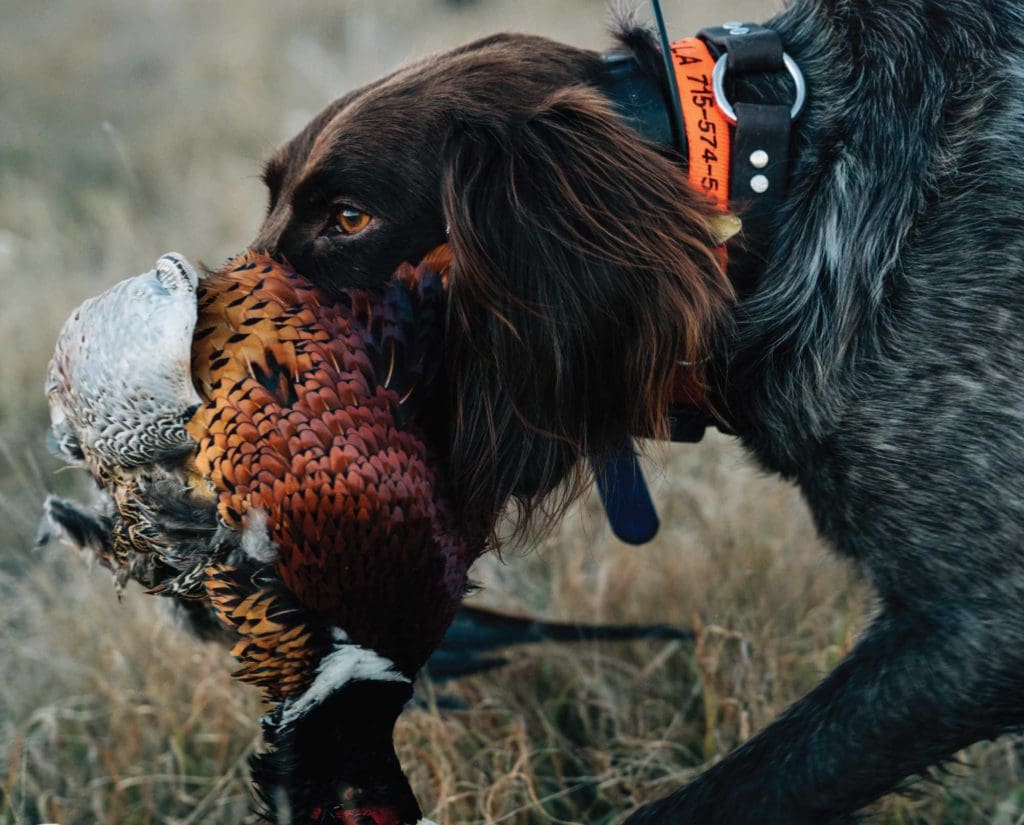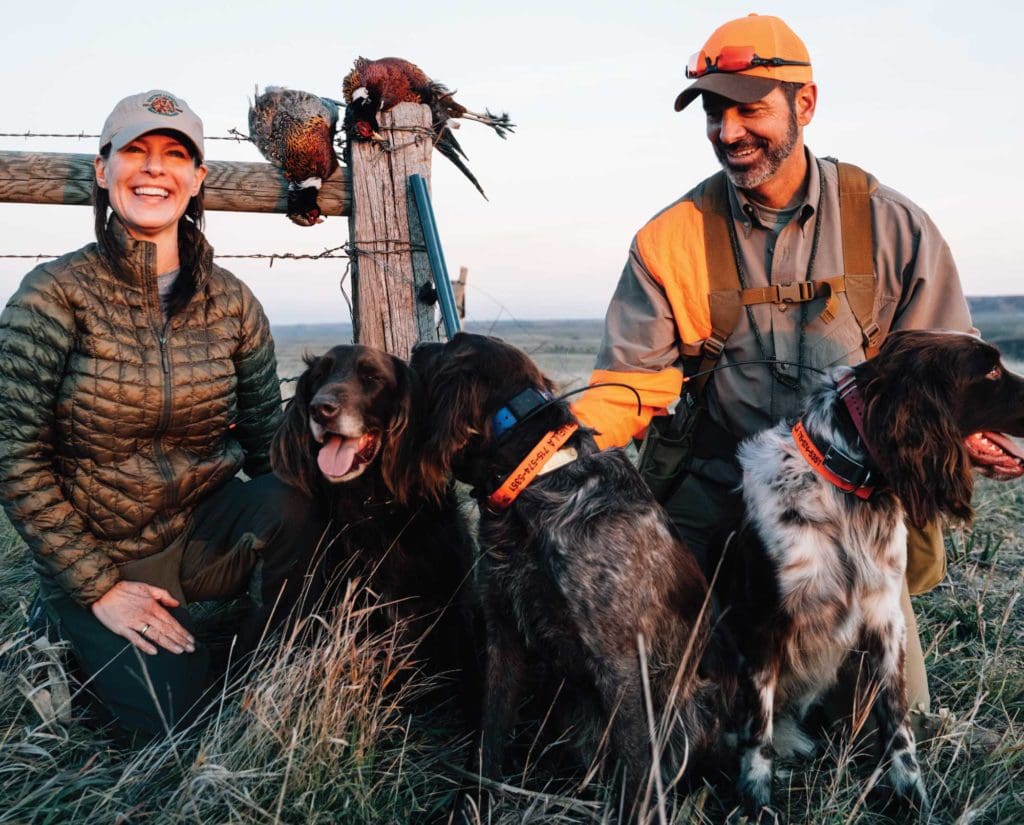Home » Hunting Videos » For the Love of Dog – The Deutsch Langhaar of North America
For the Love of Dog – The Deutsch Langhaar of North America

Jennifer Wapenski is the Director of Operations and Managing Partner…
Adam has been involved in the outdoor industry for over…
Watch the origin story of the Deutsch Langhaar in North America with the DL-GNA club
This film is presented by: Eukanuba Sporting Dog
The sun approached the western horizon of South Dakota against all of our wishes. That familiar ache of fading daylight was punctuated by the sad fact that we’d all be headed home the next morning, leaving the magic of November in the Dakotas for another year.
After regrouping to discuss our strategy for the walk back toward the trucks, we drifted apart in slow motion, as if slowing our pace would somehow slow the passage of time. With each of us lost in our own thoughts, it took a moment before someone noticed that the dogs were on point. And not just any point, but four generations of dogs—a seasoned veteran, her daughter, her granddaughter, and her great-granddaughter—all locked in on the same plume of prairie grass. The source of the point was soon revealed to be a hen pheasant so there was no bird taken to commemorate the moment, but we were all breathless with admiration anyway. What a legacy of fine dogs, brought together on the prairies of South Dakota by the bonds of community, all held together in this moment by the scent of a wild pheasant.

Our small hunting party wasn’t alone, either. We had come to South Dakota to meet up with members of the Deutsch Langhaar – Gruppe Nordamerika club and a sizable percentage of the Deutsch Langhaar population on this continent. Hosted each year at a longtime member’s property in the north-central part of the state, the annual club meeting is cleverly timed to coincide with some of the best hunting that South Dakota has to offer.
The annual migration of rare German hunting dogs to a tiny South Dakota town isn’t easily missed. Beyond the kind generosity of our hosts, the local community works hard to support this annual event, whether it’s catering, lodging, shuttling us out to various fields in a converted school bus, or just swinging by to say hello before heading to the Friday night football game down the road. When you call the lodge to inquire about a room for those dates, you’re usually met with, “You comin’ for Jake’s dog thing?”
“Jake’s dog thing,” better known as DL Fest, is a remarkable example of a breed club coming together in support of the dogs they love. The long weekend includes a breed show, club business, fundraising, and of course hunting. Judges are flown in from Germany to evaluate each breeding candidate’s conformation, which is part of the certification that all Deutsch Langhaar must complete prior to breeding.

Practically speaking, the event is a productive weekend to secure the future of the breed. Dogs get certified for breeding and breeders are able to see potential stud dogs firsthand, in their element. But to be honest, we’re all hunters first, and the draw of hunting with 40 to 50 Deutsch Langhaar in a place like South Dakota makes the cross-country drive worthwhile. This tug at the hunter’s heart is even stronger for our German judges, who are always eager to board a plane, see our dogs, and hunt a wide-open landscape that is unlike anything in their home country. It’s not an exaggeration to say that this event serves as the heartbeat for the entire breed in North America. Under the roof of the municipal airport hangar and between the rows of milo and corn, social connections are formed over a shared love of these special dogs.
Back at the hangar after our last hunt, an assembly line had formed around the bird cleaning station. We rolled up our sleeves, brought our pheasants to the table, and joined in on the cleaning, packaging, and freezing. It looked as though everyone had enjoyed a productive day afield and would have many delicious meals ahead.
The monotony of cleaning birds let my mind wander over the past couple of days. We’d made the long drive from western Washington to South Dakota with only a brief overnight stop in Miles City, Montana. Upon crossing over the state line into South Dakota the next morning, we pulled off the highway into the first public land we encountered to let the dogs stretch their legs. My first impression of the National Grassland matched the rumors we’d been hearing: the dry summer had led to aggressive grazing on these grasslands. My heart sank as my visions of striding through knee-high grass were replaced with the reality of little dry nubs. Before that thought had time to sink in, though, a large covey of sharp-tailed grouse flushed from the ditch beside the road.
“Seems like a decent place to stop,” Joe said with just the right amount of understatement. I nodded in wide-eyed agreement and we drove ahead to the next pullout. Fresh from 18 hours on the road, both dogs hopped out and took in their unfamiliar surroundings with the joy that only a bird dog on the prairie can express. We gathered our gear and set off in an arcing route towards where the birds had gone.
Those sharptails knew everything they needed to know about us, and they were over the horizon before we ever got close. But within moments, Piper was on point a couple of draws over. Sharptails were already popcorning out of the bushes as I crested the hill; my heart leapt as I connected with one. Joe shot a second bird and sent the dog for both retrieves. I had hardly finished lacing my boots and now held a beautiful grouse in my hands. Guess we’re in South Dakota now.
The fairytale was short-lived, though. Piper was on point again, looking at the same type of draw-bottom cover that had yielded the weight in my pack at the start of our loop. I should have noticed the way that her tail was flagging. I hurried in, brimming with anticipation, just in time to see her gingerly pulling a porcupine out of the thicket by its tail. A string of incoherent sounds came out of my mouth, signaling to Joe that there would be no birds to shoot off of this point.
Piper was a champ for the removal of all sixty-odd quills and we counted ourselves lucky that she’d apparently used only her lips for gripping the pokey critter. She may be a German dog, but she’s a classy one.
READ: Porcupine Quills and Dog Encounters: A First Aid and Avoidance Guide

The smell of dinner on the grill snapped me out of my memories and back to the present. People were gathering around and filling plates with food. All the dogs had been fed and were resting in their crates, probably replaying the memories of the hunt just like I’d been doing. Do they think about that one magic moment, the handful of missed opportunities, and the pure joy of hunting with their people? I’d like to think so. I washed up, grabbed a plate, and joined the line of hungry, happy hunters. What a day, what a weekend, and what a community.
Our parting words to each other all revolved around doing it again next year. How could we not? Exceptional hunting dogs in the hands of dedicated hunters—it’s a siren’s song that draws us back to the same prairies and fields every year, following our dogs wherever they may lead.
Jennifer Wapenski is the Director of Operations and Managing Partner at Project Upland Media Group. She has a lifelong passion for the outdoors, dogs, and wildlife; as an adult, she discovered that upland bird and waterfowl hunting were natural extensions of these interests. What started as initial curiosity soon escalated into a life-changing pursuit of conservation, advocacy, and education. Jennifer serves in a variety of roles such as the Breed Warden for the Deutsch Langhaar—Gruppe Nordamerika breed club and on an advisory committee for the Washington Department of Fish and Wildlife.
Adam has been involved in the outdoor industry for over 10 years, and an enthusiast since he was old enough to carry a shotgun. He is a father of two, photographer, writer, upland hunter, fly fisher, and the middle brother out of the three that are Modern Wild - a company started out of love for the outdoors and its many communities.



